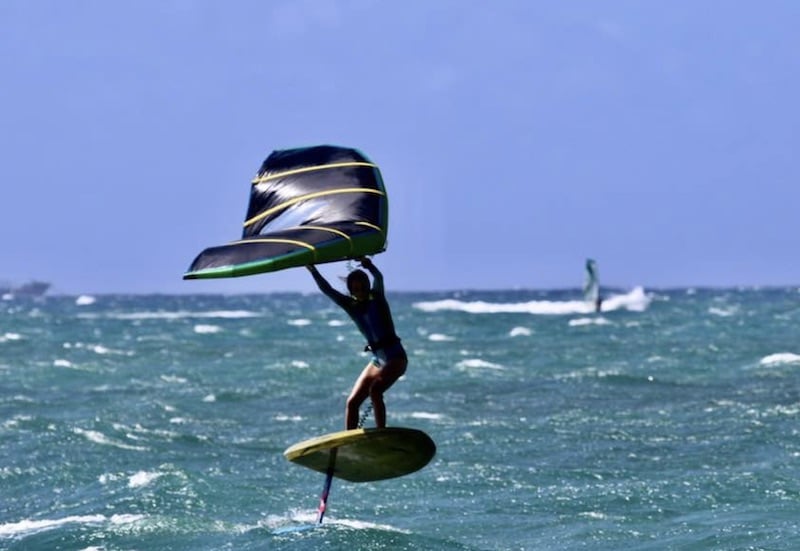Whatever its future, possible or not, Wing Foil must be placed in its context.
Let’s take the last fifty years, between 1970 and today. In terms of means of going on the water, and more particularly, ‘sportive’ sailing, the size of ‘sailing vessels,’ or rather the size of the interface between man and sea, has continued to decrease. Successively, there has been:
- the monohull
- the sports catamaran
- windsurfing
- kitesurfing
- the foil
Compared to windsurfing or kitesurfing, Wing Foil may seem ‘absurd.’ For now, it’s a concept in full development, the usage range is low (between 20 and 30 knots), brands navigate blindly.
It will attract early adopters; we will judge what follows. It could influence kitesurfing, weigh on the evolution of surfing that will ‘break out’ of the strict framework of breaking waves, perhaps bring practices into inland waters. The challenge is not so much to know if it will work, if it’s a gadget for social networks or a sustainable innovation, the challenge is to try to understand what this initiative will produce in the long run.
Another important parameter is the possibility of innovation.
Some sports worlds are not subject to rules, or at least, these rules are not constitutive of their identity or source code. Let’s take a counterexample: in tennis, no matter the match, whether at Wimbledon or in the depths of Corrèze, after 15-30, there may be 30-A or 15-40. No one would think to imagine otherwise. . The place of the net is unlikely to be questioned. Outdoors or on the water, rules exist, in trail or surf, but the norm is more on the side of ‘free’ or freeride practice. The space to innovate is limitless. End of this preamble.
Photos of the ‘craft,’ what we call the Wing Foil, quickly circulated on social media. Just as quickly, influential brands ‘positioned’ themselves. Following Duotone, F.ONE with images of Raphaël Salles himself, Naish and Robby who couldn’t resist either, Slingshot, GoFoil… This weekend, Kaï Lenny also got involved.
What is it about?
A hybrid board, derived from the evolution of stand-up paddleboarding, but shorter (6 feet), equipped with a foil, of course, and propelled by an inflatable wing that recalls a kitesurfing wing, but isn’t really one.
Important detail, there is no connection between the ‘rigging’ and the ‘skiff,’ and one quickly guesses that evolving with such equipment is no small feat. That’s not the problem anyway. Without going back to the Duchess of Berry, one of the first to take an interest in the coastline, but only referring to 1936 and the nascent enthusiasm for sea bathing, who would have thought that an ordinary human could kitesurf. Everything is relative; man distinguishes himself by his adaptability.
The idea of a hybrid wing that sustains is not new. It dates back to the 1980s with attempts in Brittany and the Oregon Gorges, in particular. At the time, windsurfing was at its peak; later, kitesurfing would take the lead, the initiative remained there.
To fully understand the tortuous path of innovation, one must take the puzzle pieces one by one. It is the foil that now sets minds bubbling and reshuffles the cards.
The foil, an appendage that resembles a miniature airplane, lifts the board and reduces drag (friction). It allows not only for little power but also for a very small board, since it is only needed at the start. That’s the technique. What’s the difference from kitefoiling, you ask?
- No lines. In kitesurfing, the ‘strings’ (the correct term is lines) average 25 meters; it’s one of the elements responsible for traction, but also a limiting factor in implementation. Also a danger factor.
Wing Foil is a puzzle. A reassembly of the existing made possible by both technological innovation and the evolution of minds. Particularly progress on foil surfaces (1800 cm square for F.ONE with a 75 cm mast). For now, the size of the wing (between 2.5 and 4 square meters) limits the range of use. It takes at least 20 knots.
Before finding this innovation ‘strange,’ one must review various parameters one by one. Trying to gauge its future is not even the point. The important thing is to understand the mechanisms at play.
- Foil manufacturers target the global surf market
- The development of foil could change the practice of surf itself.
- Everything surrounding this evolution is, therefore, strategic.
- The wing becomes a kind of ‘peripheral’ to the board. Like the paddle
- One can imagine a central board usable with or without foil (it exists), propellable with or without paddle, with or without ‘wing.’
- The way to go to sea evolves. The future is a light, even ultra-light, low-impact practice.
- Mobility is a determining factor today. The Wing Foil equipment is easily transportable. By car, even by train.
Compared to windsurfing or kitesurfing, Wing Foil may seem ‘absurd.’ For now, it’s a concept in full development, the usage range is low (between 20 and 30 knots), brands navigate blindly.
It will attract early adopters; we will judge what follows. It could influence kitesurfing, weigh on the evolution of surfing that will ‘break out’ of the strict framework of breaking waves, perhaps bring practices into inland waters. The challenge is not so much to know if it will work, if it’s a gadget for social networks or a sustainable innovation, the challenge is to try to understand what this initiative will produce in the long run.
In the meantime, let’s get excited.










